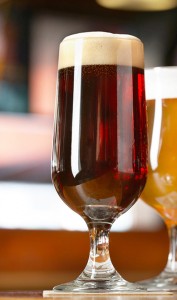Pucker up, my friends! Today we look at sour beers, simply because I was recently involved in a conversation that, itself, turned sour. I was engaged in a bitter pissing contest with a total stranger who thought he knew more about beer than I do. We started off on the wrong foot when he suggested to me hangover remedies. (Bitch, please.) Matters escalated as we one-upped each other nastily until he asked with a challenge in his voice, “Well, have you ever had a sour beer?” I answered that I had and I quite liked them and I just tried several at the Jolly Pumpkin in Ann Arbor thank you very much. Then I stopped listening.
Sour beers do live up to their name, and some consider them an acquired taste. I hasten to mention that one needn’t be a sour puss to enjoy this style, in fact it helps if you maintain inner reserves of sweetness; but if you don’t at least try one, I will call you a sour pussy.
Sour beer is an old tradition, begun in Europe back before brewers and consumers were so nitpicky about having unknown variables floating in their brews. The sour flavor comes from the wild yeasts used to ferment the batches as well as live bacteria. Wild yeasts being the unpredictable beasts they are, brewing sour beer can be a challenge, but when it’s done right it’s a delightful mix of untamed tastes and solid chemistry. So good I wouldn’t even waste it by tossing it in that little pucker’s face.
The phrase sour beer actually encompasses a number of different ale varieties, including the Berliner Weiss, Flanders in all its permutations, Gouze, Lambic, and Kriek. These range in taste from the bright tartness of a Berliner to the fruit-heavy sweet-and-sour punch of a Lambic.
Adding fruit is another method for achieving maximum tartness. I, myself, am a bit of a tart, and fell in love with the Cambridge Brewing Company’s cherry kriek, Cerise Cassée, many years ago. It seemed customers either loved or hated the beer, which was made by adding 300 pounds of sour cherries to each year’s batch and storing the elixir for up to eight years in French oak wine barrels. Each glass contains kriek that was recently made mixed with eight-year-old kriek. It is fancy-pants and super sour, and loving it placed me in a private club of People with Excellent Taste. Also, I rarely had to share my beer.
At the Jolly Pumpkin a few weeks ago, I tried several outstanding sour beers. I did not try the one listed in this Top 10 Sour Beers article from Paste Magazine, but rather had a seasonal called Luciernaga or “The Fire Fly.” I was expecting something like a Belgian IPA, but this was something gentler, more delicate, and brighter.
As we speak, I am sipping on Bam Noire from the same brewery. I have often been accused of being a “hop-head,” so here’s me proving I’m versatile. Bam Noire is a dark farmhouse ale that is a complex combination of smooth malt and effervescent tartness. I am already wishing I had more than one bomber of it.
So this dude, though, just kept going, despite the look of abject disinterest on my face that I was hoping masked the murderous notions curdling in the back of my mind. Finally he explained his expertise was because he “worked in the beer industry.” In what capacity, he did not make clear. I sighed and answered that I was the beer industry.


